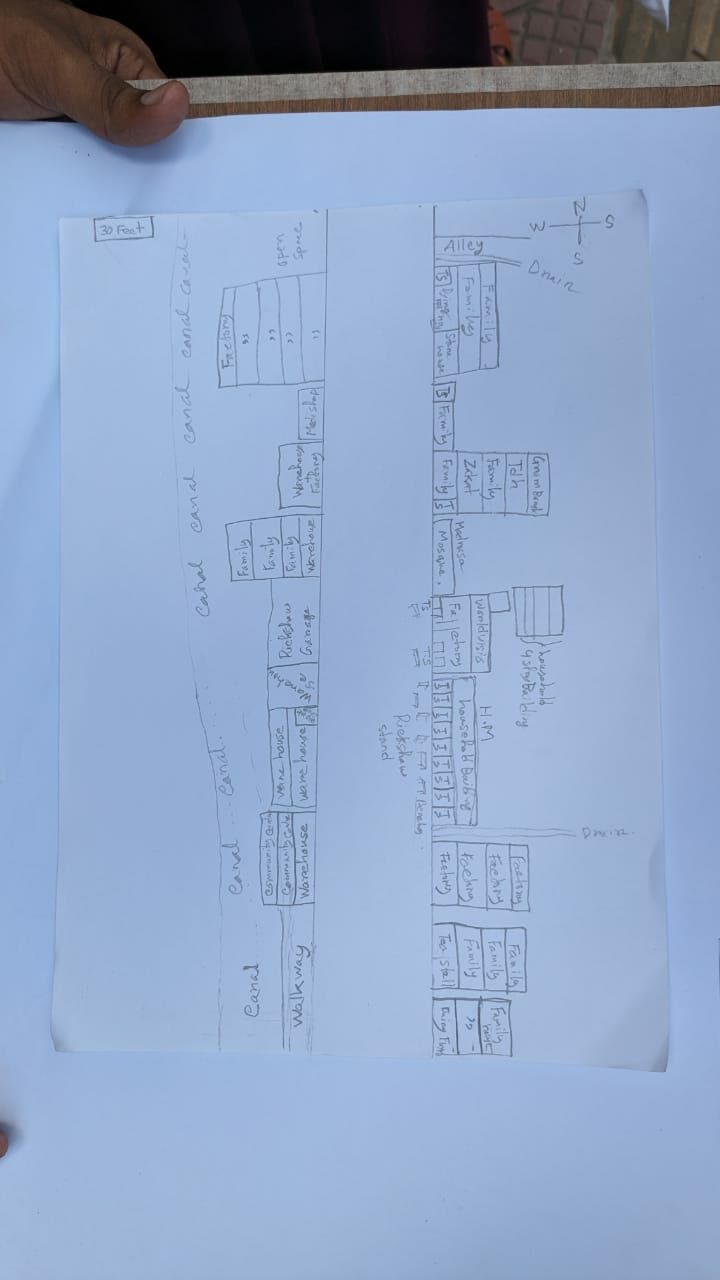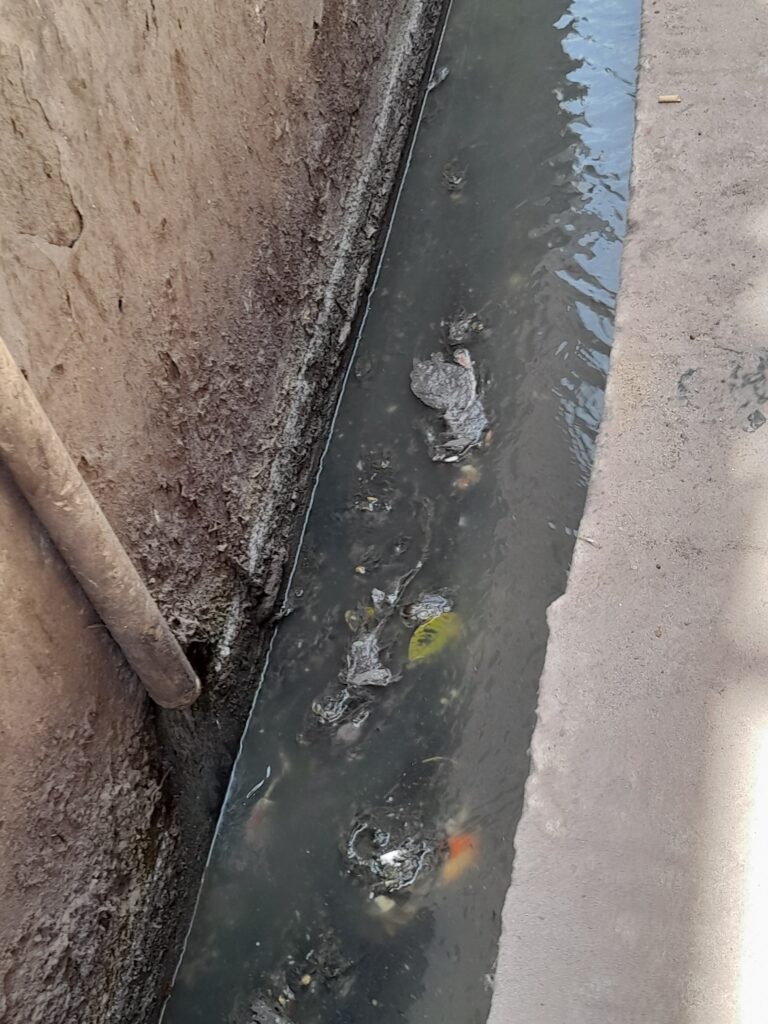
An urban slum surrounded by leather: How leather processing and production exposes children to hazards in Hazaribagh, Dhaka
Hazaribagh is the historic centre of leather processing and production in the city of Dhaka, Bangladesh. Many of the road names – Royal Tannery Lane, Bangla Tannery Road – indicate its recent past as a tannery zone making leather from raw cow and goat hides. In 2023, around 150 small and medium enterprises were operational in Hazaribagh making leather hand gloves for construction, shoes, key rings and other leather products.
Situated along the Buriganga river, Hazaribagh is densely packed with compact multi-storey residential settlements, situated above, beside and behind the commercial units and leather factories. There is very little space in the centre of Hazaribagh, with narrow roads and alleyways between buildings (see map).
The street selected by children for CLARISSA participatory mapping runs from north to south through the slum neighbourhood of Gojmohol, which is home to approximately 1,650 households and 2,450 children (according to a census conducted in November 2020). The majority of the residents of this neighbourhood experience poverty, many have migrated to the area in search of work. They navigate insecure living conditions, limited access to schooling and a lack of healthcare provision. Many of the children who live in the neighbourhood work.
On 24th July 2023 a CLARISSA research team immersed themselves in the day-to-day life of the street. the research team comprised two members of CLARISSA’s children’s research group (a 15-year-old girl and a 16-year-old boy) and an adult researcher. The research team were particularly focused on making observations about the physical environment of the street, the activities of children on the street and about how things changed over the course of the day, noting interactions between environmental variables like heat and light and people’s behaviour.

An aerial map of Hazaribagh, with green indicating areas dense with buildings and brown indicating vegetation. The street selected by children for this participatory neighbourhood mapping project is located in the northern part of the map

Street description
The 30 Feet Road
- Residential Building
- Commercial Building
- Factory or warehouse
- Mixed Used
- Mosque
- Shop
- Garage
- Electricity Office
- Water Pump
Hand-drawn version of an aerial street map created by researchers, children and an accompanying illustrator.

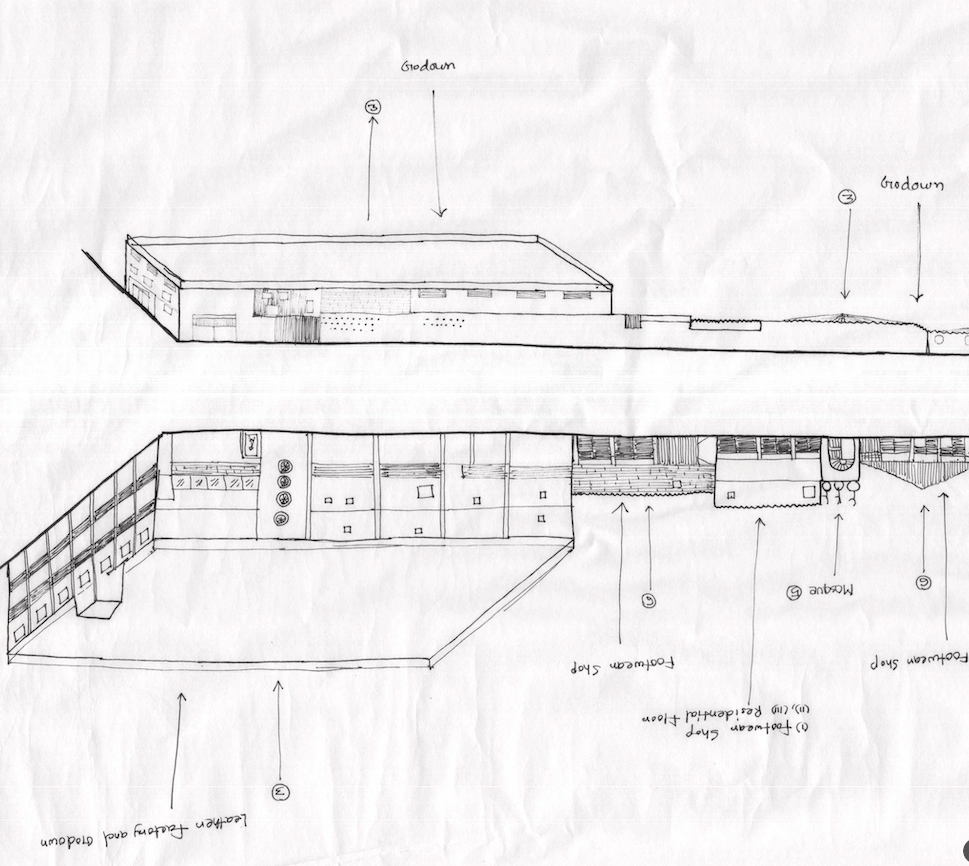
One end of 30 Feet Road is flanked by leather factories and storage facilities.
The street is wide, as its name – the 30 Feet Road – suggests. It is a mix of low rise and medium rise buildings of 5-6 floors. Along with residences, madrasas and mosques, neighbourhood stores and tea shops the street comprises leather factories and leather shops on both sides. There is a particular concentration of footwear shops on the street. Some of the historic leather factories which were left when the industry moved to Hemayetpur in 2016 have become “godowns” which are warehouse and storage facilities, as can be seen at one end of the street.
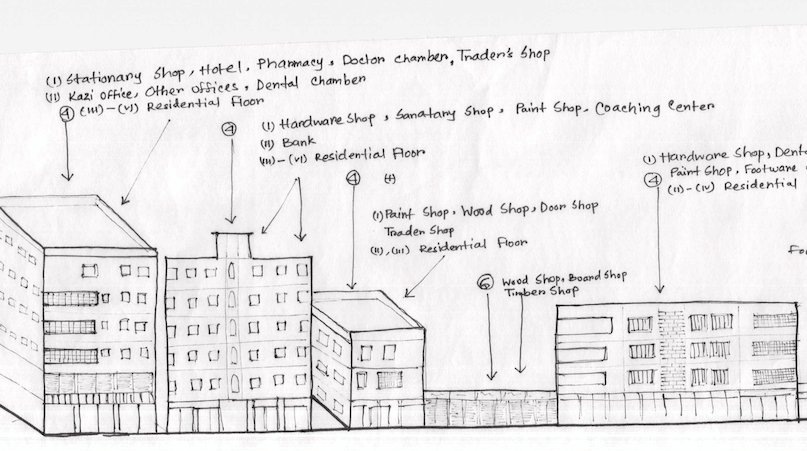
A collection of mid-rise mixed-use buildings at one end of 30 Feet Road. Upper floors are residential and ground floors are commercial.
Here are some large residential buildings and some large mixed-use buildings, comprising offices, doctors surgeries, pharmacies, stationary shops, banks, hardware shops, educational coaching centres and residences.
There are also tea shops, leather shops and shoe factories.

Low-rise leather factories and footwear producers (footwear shops) at street level with residential floors above.
The distinctive aspect of this street is that almost all buildings have multiple uses for their floors. The ground floor of almost every building comprises one or more small leather factories, shoe factories and leather shops. Above the business units are residential units.
A great many people pass through the street on foot. Pedestrians include people shopping and children on their way to school or to madrassas.
The street is heavy with traffic. Motorbikes, and vans piled high with leather go from one end of the road to the other, serving the larger leather factories and warehouse facilities at either end of the street.
Overall noise of the road
Characteristics of the street
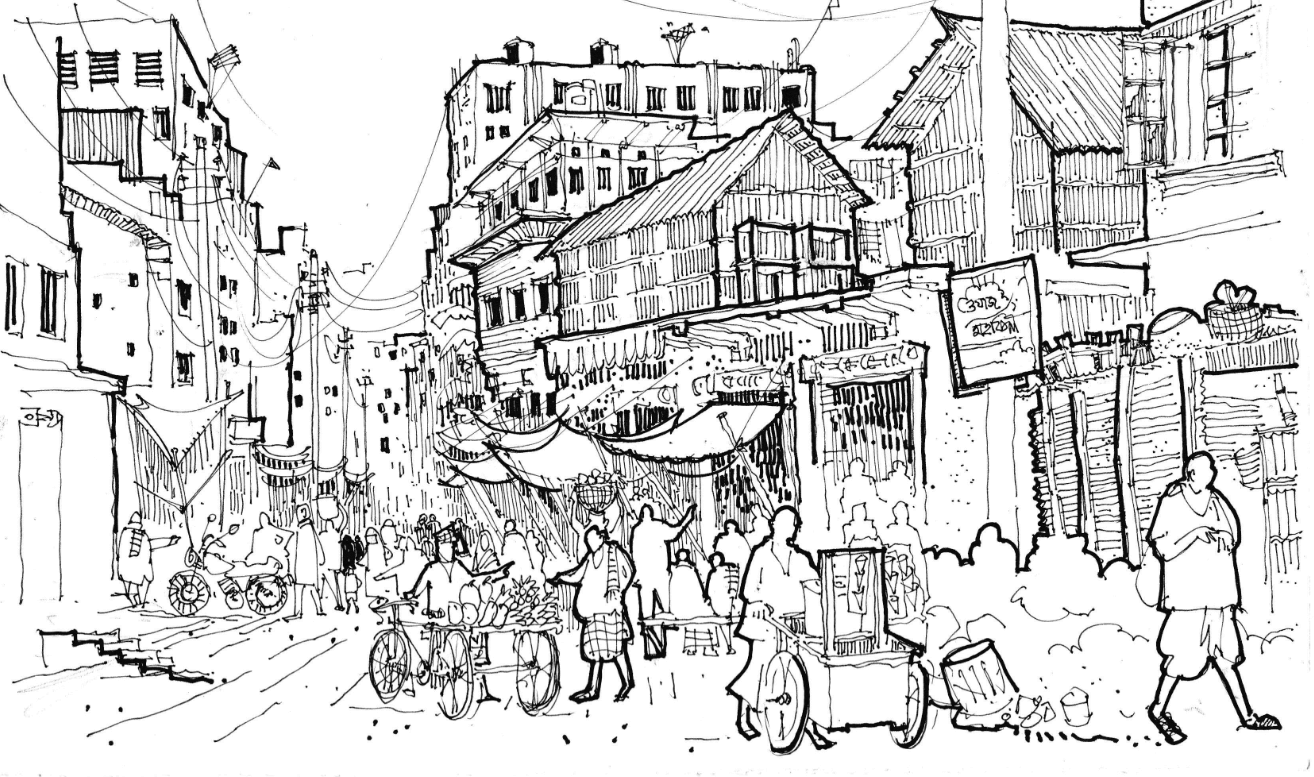
The hustle and bustle of morning time on the 30 Feet Road. A lot of trade is taking place in the middle of the street to passing pedestrians.
The heat
The street is hot and polluted, and there are no safe places for children to play, despite children being a strong presence on the street.
The research team observed the 30 Feet Road on a bright sunny day. By the afternoon it was extremely hot:
Given that the sun is currently directly overhead, the road is considerably hotter than the sky.
Adult researcher
The heat is extreme in this neighbourhood and has a considerable effect on people. Purchasing water and finding shade in some of the tea stalls is a priority for many people passing down the street.
The research team experienced the heat first-hand, with the adult researcher reflecting:
Even though I started the day with an umbrella and two bottles of water, the water was gone within the first two hours. I was extremely thirsty the entire day, to the point where I almost passed out at 1 p.m. I then purchased more water and took it with a saline sachet Then, I started to feel a little better, but I also understood that this is how the residents of this street spend their days. They might not immediately have access to water or salt when they are working, unlike me.
Adult researcher
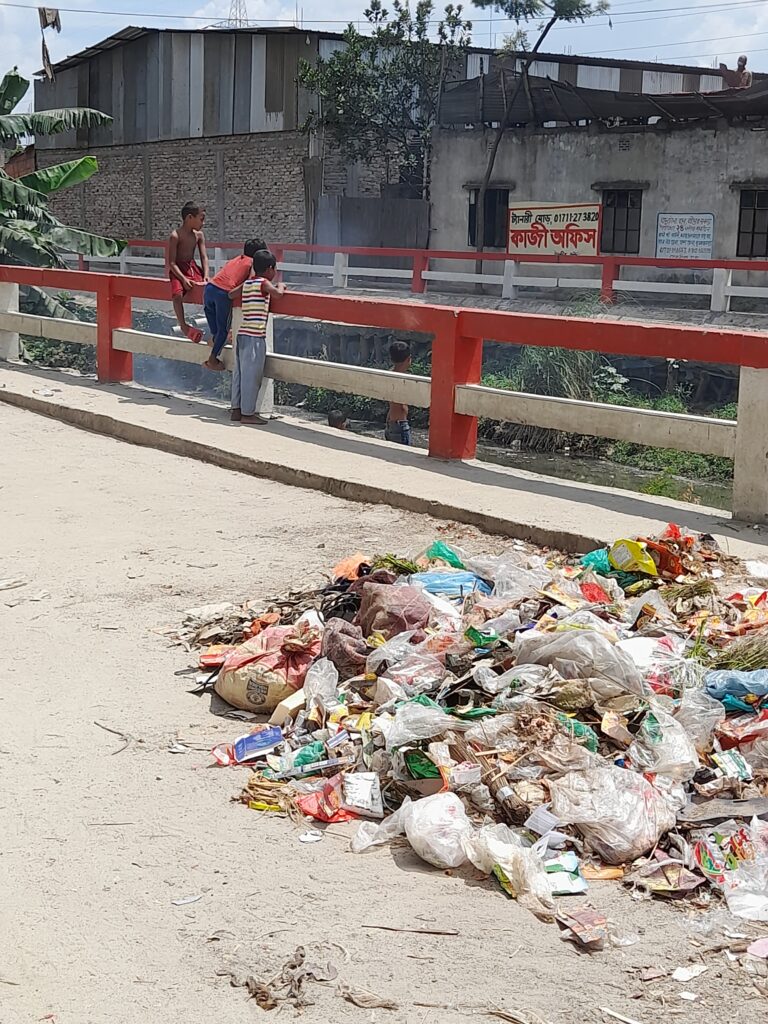
Unattended children gathering near piles of rubbish and at risk of falling into the drainage canal.
The pollution
The concentration of leather industry on the street creates a foul smell, which is worsened by open drains. At one end of the road, there is a small lake. The water here is black, and the research team assumed this is because people dump their rubbish into it. The factories also release chemicals into it.
Household and business rubbish accumulates over the course of the day. At one point a van of waste pickers comes by to take some of it. by. The rest remains as a feast for street dogs and flies.
No safe place to play
The children who live along the street have no safe place to play. There is no playground.
Some girls were seen being walked to school by parents in the morning, there they saw very few boys in this situation. Most of the boys observed on the street seemed to be working. Younger children play on the road unaccompanied, amidst construction materials. Many of them are shoeless and scantily clad.
I have gone down into this drain before, it is not just me but many of my friends and neighbours have unintentionally fallen into these drains. Child researcher, 16 years old
’Anyone can fall in the open drains. A young girl just told me that she once slipped and fell into a drain, and when her brother went to help her, he fell in too. Onlookers helped them out Child researcher
Even though there are streetlights, the road felt extremely unsafe after sunset, especially for the female researchers. As one local girl summed up:
You are a newcomer here, and even the neighbourhood’s female residents do not feel secure walking down the street after dark. Local girl and resident
Children
Children working in leather businesses
Many children were seen coming in and out of the businesses dedicated to the production of leather along the street.
During the afternoon children spilled out of a factory for lunch. More girls than boys came out.
Up to 40 children were seen coming out of one factory at lunchtime.
Throughout the day the research team also observed carts of leather being pulled or pushed up to factories by children aged 10-15. Aside from the loading and unloading of leather however, not much leather sector related activity takes place directly on the street. It mostly happens on the ground floor of the buildings, where the CLARISSA research team did not enter in the context of this particular mapping exercise.
As the day came to an end, the factories still seemed to be in full operation, despite regular working hours being over:
I can still see employees inside two of the factories, and I assume they are putting in extra hours. However, most employees have left the factory. Those who remain are both male and female. I can assume that it is very hot and humid inside these factories.
Adult researcher

There are notices pinned around from various NGOs opposing child labour but I am curious how many locals are reading and taking notice. low-cost child labour seems prevalent in this area. Adult Researcher
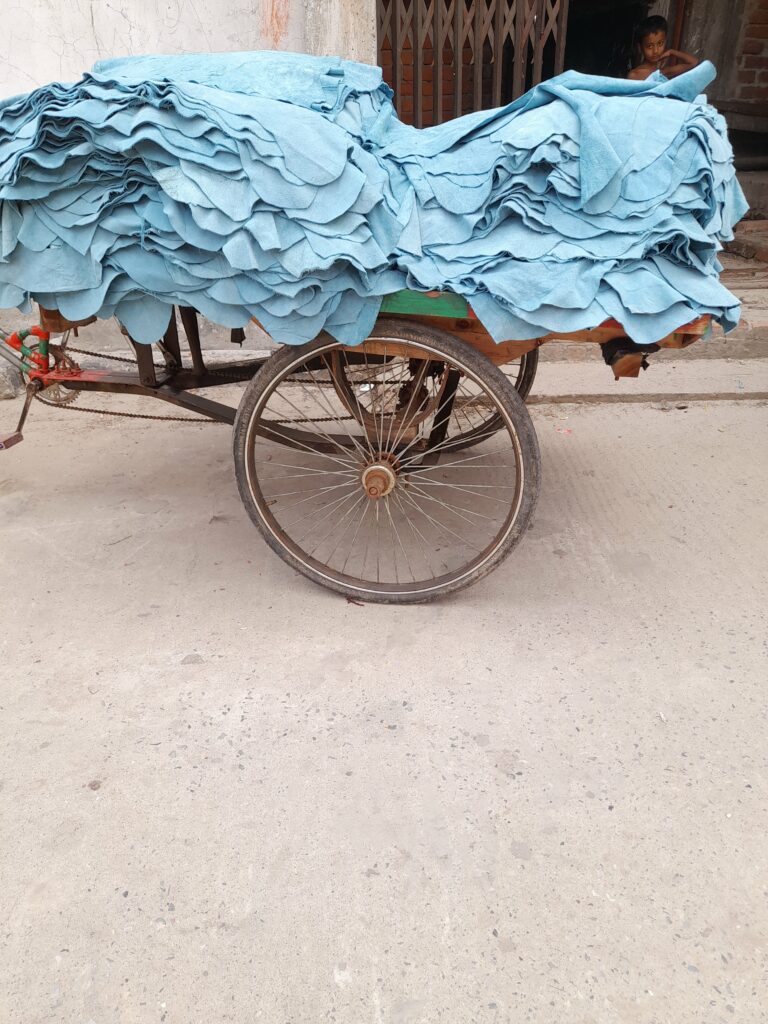
Sheets of leather piled up on a three-wheeled cart

Leather being transported along the street
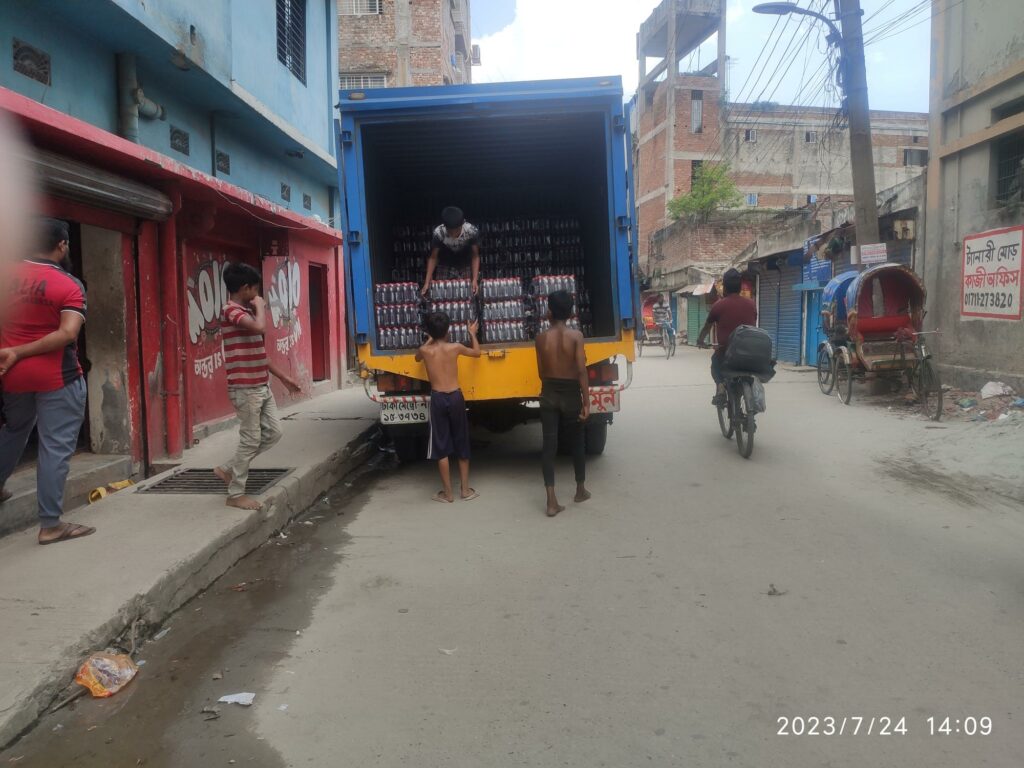
Children unloading drinks into a warehouse.
Children working on the street
Children were also observed engaging in street vending or working in local restaurants.
The researchers observed several teenage boys employed in a machine repair shop. They were listening to popular Hindi songs on a phone connected to an old speaker. They were wearing worn clothes and using an electric fan for some respite from the scorching heat.
a boy of about 14 carrying a large bottle of chemicals. The owner reprimands him and orders him to work more quickly. The child is perspiring a lot because it is a humid evening. His skin is dark, probably from working in the sun every day. His demeanour and facial expressions suggest that he is in emotional distress Child researcher
Crates of drinks are being removed from a truck by three children, ranging in age from ten to twelve. Their adult supervisor is yelling at them. They are clearly struggling with the heavy crates. And seem at risk of being injured. Adult researcher
Unhygienic food conditions
Many of people living and working on the street were observed eating at the various stalls and restaurants along the street, including children.
Street food vendors were seen not to wear gloves or wash their hands before handling food, and hygiene also seems to be an issue in the restaurants.
Women oversee many of the restaurants. One of them breaks from preparing breakfast for the guests and starts sweeping the ground outside. When a customer arrives, she serves him food without first washing her hands. While sweeping, she does not cover the food. Child researcher
In the tea shops, all the cups are washed in the same water. There is a bucket of water in the store that may have been initially fresh when it was brought in but is now filthy. The seller uses this dirty water from the bucket to wash cups each time. Adult researcher
Discussion
The 30 Feet Road, is a bustling part of the Hazaribagh neighbourhood where the presence of the Bangladeshi leather industry is strongly felt. The road is home to numerous leather factories, warehouses and mixed-use buildings. Smaller leather businesses and private residential units are found next to large-scale and formally registered enterprises. Banks, hotels, madrasas and mosques also have a presence on the street.
Detailed observations of the street and its characteristics provide a glimpse into the lives of its residents and those who work there, revealing a complex pattern of struggles, concessions, and difficulties that define this community and particularly the experiences of children within it. Street infrastructure does not exist to match the multiple demands that arise from the current mix of commercial and residential buildings and as such many interrelated struggles can be seen to play out in this hot, polluted and poorly managed environment. One such serious problem is the high presence of unattended children playing in unsafe spaces on the street, amongst traffic and industrial and toxic materials, exposed pipes and polluted drains. Accidents falling from rooftops and into drains frequently happen.
Everyone finds it difficult to stay cool and hydrated. Pollution from leather factories mixes with open sewers to creates a pervasive stench. The levels of pollution have to some extent become a normal part of living on the street, illustrated in poor hygiene practices around food preparation and consumption. Girls in particular experience the street as an unsafe place for them, which is why many of them are accompanied on the walk to and from school. The road becomes more precarious after sunset, when girls and women particularly report not feeling safe on the street.
Literature on child labour often describes the worst forms of child labour as being “hidden” but on the 30 Feet Road one sees children at work everywhere. Even though the research team were limited by consent and safeguarding procedures in their ability to enter buildings to observe the work that children do (this is covered by other aspects of CLARISSA research), children were a visible and integral part of the workforce on the street, loading trucks and spilling out of factories at lunchtimes. Children were seen working in hot and humid conditions, carrying heavy loads and handling chemicals. It’s possible that the visibility of child labour has normalised and reinforced practices of hiring children within this neighbourhood. If, for example, one lives on the street, and travels very little outside, it would feel normal that children work. It might even feel safer to put children in work, where there is some adult supervision, rather than leave them unattended while parents work. Bringing children into the research team to observe the street and its dynamics changed how these children viewed where they live:
I have never had such a clear view of my own neighborhood. Every day, I walk down this road, but I never pay it the same attention as I did today. I did not look at the people or what they were doing all day. I usually walk with my eyes fixed on the road, today was the first time I really paid attention to anything.
Child researcher
It is striking how much the leather industry defines life on this street for children – either by providing (dangerous) work for children or by directly and indirectly creating hazards (chemical waste, traffic) that all children living and moving along the street are exposed to.
The neighbourhood mapping process
Neighbourhood mapping is a way of understanding children’s experience of urban neighbourhoods and identifying the characteristics of urban neighbourhoods that contribute to the emergence and perpetuation of Worst Forms of Child Labour. CLARISSA has mapped neighbourhoods where different stages of leather processing and production are represented and where children are known to work. Children residing in the Gojmohol neighbourhood of Hazaribagh selected the 30 Feet Road to map as they feel this street depicts overarching themes and issues pertinent to their neighbourhood. They believe the story of this street will act as an illustrative summary of what happens in their community throughout the day.
To map the structure of the street two boys aged 16 and 17 years old from CLARISSA’s Bangladesh children’s research group and two adult researchers visited the 30 Feet Road with a photographer and illustrator. They sketched the layout of the road and took photos and videos to support their sketches and observations of the physical environment. The children collected information about the activities taking place. This information was provided to the illustrator to help him to complete illustrations.
For street observations the research team included one girl aged 15 and one boy aged 16 years old and an adult research assistant. Each child was oriented on the purposes of neighbourhood mapping and explored observational techniques during a transect walk along the street with adult researchers. As the children were residents of the area, they were also able to contribute their local knowledge and insights of the street. The children proposed observation times: two hours in the morning between 10.30-12.30pm, one hour in the afternoon between 1-2pm and two hours in the evening from 5.30-7.30pm. They did not want to continue observations after 7.30pm due to safety concerns. It was agreed that the research team would not enter budlings, but that they were able to observe the inside activities of tea stalls hotels and other shops from the street.
On 24th July 2023 the research team immersed themselves in the day-to-day life of the street, utilising a combination of direct observations, interactions with inhabitants, and meticulous documentation of the street structure. The research team were particularly focused on making observations about physical environment and environmental hazards, activities of children and about how things changed on the street over the course of the day, noting interactions between environmental variables like heat and light and people’s behaviour.
To observe 255 metres of street, the research team organised the street into sections. Each member was responsible for specific observations and after 10-15 minutes the team moved onto a new section. The team documented their observations using notebooks and mobile devices. The children who were not comfortable with writing used voice recorders to document their observations. They also took photos and audio recordings of the street.
The day after the observations, the CLARISSA research team and the children came together for a debriefing session.
